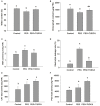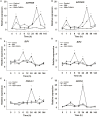Osmotic Stress Induced Cell Death in Wheat Is Alleviated by Tauroursodeoxycholic Acid and Involves Endoplasmic Reticulum Stress-Related Gene Expression
- PMID: 28515732
- PMCID: PMC5413500
- DOI: 10.3389/fpls.2017.00667
Osmotic Stress Induced Cell Death in Wheat Is Alleviated by Tauroursodeoxycholic Acid and Involves Endoplasmic Reticulum Stress-Related Gene Expression
Abstract
Although, tauroursodeoxycholic acid (TUDCA) has been widely studied in mammalian cells because of its role in inhibiting apoptosis, its effects on plants remain almost unknown, especially in the case of crops such as wheat. In this study, we conducted a series of experiments to explore the effects and mechanisms of action of TUDCA on wheat growth and cell death induced by osmotic stress. Our results show that TUDCA: (1) ameliorates the impact of osmotic stress on wheat height, fresh weight, and water content; (2) alleviates the decrease in chlorophyll content as well as membrane damage caused by osmotic stress; (3) decreases the accumulation of reactive oxygen species (ROS) by increasing the activity of antioxidant enzymes under osmotic stress; and (4) to some extent alleviates osmotic stress-induced cell death probably by regulating endoplasmic reticulum (ER) stress-related gene expression, for example expression of the basic leucine zipper genes bZIP60B and bZIP60D, the binding proteins BiP1 and BiP2, the protein disulfide isomerase PDIL8-1, and the glucose-regulated protein GRP94. We also propose a model that illustrates how TUDCA alleviates osmotic stress-related wheat cell death, which provides an important theoretical basis for improving plant stress adaptation and elucidates the mechanisms of ER stress-related plant osmotic stress resistance.
Keywords: ER stress; ROS; TUDCA; cell death; osmotic stress.
Figures







References
-
- Aebi H. (1984). Catalase in vitro. Meth. Enzymol. 105, 121–126. - PubMed
LinkOut - more resources
Full Text Sources
Other Literature Sources
Miscellaneous

